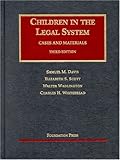Children in the legal system : Cases and materials
Publication details: New York Foundation Press 2004Edition: 3rdDescription: 243pISBN:- 9781587785214
- 345.081 DAV
| Item type | Current library | Shelving location | Call number | Status | Date due | Barcode |
|---|---|---|---|---|---|---|
 BOOKs
BOOKs
|
National Law School | Library Compactors | 345.081 DAV (Browse shelf(Opens below)) | Available | 26462 |
TABLE OF CONTENTS:
Chapter I: Allocating Power Over Children: Parental Rights and State Authority;
A. The Constitutional Parameters of Parental Authority;
B. Parental Rights: The Case of Unmarried Fathers;
1. The Supreme Court and Fathers' Rights;
2. Adoption Placement and Fathers' Rights;
Chapter II: Children as Legal Persons;
A. Introduction;
B. Paternalistic Policies of Restriction and Protection;
1. Limited Accountability in Contracting;
2. Restriction on Free Mobility: Curfews;
3. The Right to Vote and the Age of Majority;
C. Minors' Right of Free Expression Under the First Amendment;
1. The Traditional Approach;
2. Children as Persons Under the First Amendment;
D. Children's Participation in Decision making in Legal Contexts;
1. An Argument for Participation;
2. Minors' Consent to Medical Treatment;
3. Adolescent Reproductive Autonomy;
E. Emancipation: Adolescents as Legal Adults;
F. Adolescence: A Separate Legal Category?;
Chapter III: Children's Rights and School Authority;
A. Introduction;
B. The First Amendment in the Public School;
1. Free Expression;
2. School Newspapers And The First Amendment;
3. Issues Of Religious Expression;
C. Constitutional Issues in School Discipline;
1. Procedural Due Process;
2. Corporal Punishment;
D. The Fourth Amendment and Public School;
Chapter IV: Custody;
A. In the Best Interests of the Child;
B. The Concept of Psychological Parenthood;
C. Using Past Caretaking Roles To Allocate Responsibility in Custody Decisions;
D. Joint Custody;
E. Visitation;
F. Limitations on a Child's Role and Preferences;
G. Disputes Over Removal or Relocation;
Chapter V: Intervention in the Family to Protect Children;
A. The Child Protection Umbrella;
B. Neglect, Dependency and Endangerment;
C. Special Problems of Child Abuse;
D. The Special Case of Munchausen Syndrome by Proxy (MSP);
E. Defining "Abuses" and Determining When and How to Intervene;
F. Special Evidentiary Problems;
G. "Medical Neglect" and Its Special Treatment
Chapter VI: Foster Care and Its Changing Role;
A. The Legal Framework;
B. Relationships Within the Foster Family;
C. Permanent or Long Term Foster Placement;
Chapter VII: Termination of Parental Rights;
A. Introductory Note;
B. Requirements of Proof and Representation;
C. Criteria for Intervention;
Chapter VIII: Adoption of Minors;
A. A New Look for An Old Institution;
B. Who Can Adopt? The Importance of State Laws and Their Construction;
C. Requirements of Notice and Consent;
D. Placement;
E. Adoption of Children with Special Needs
F. Access to Adoption Records;
G. Civil Effects of Adoption;
H. Open Adoption;
Chapter IX: The Juvenile Justice System: Changing Perspectives;
A. A Look Back;
B. The Juvenile Court and the Constitution: The Gault Case;
C. Testing the Premises of Gault: Winship and McKeiver;
D. Beyond McKeiver;
E. Participation of Counsel in the Juvenile Process;
1. Scope of the Right to Counsel;
2. The Role of Counsel;
Chapter X: Delinquency: Differential Treatment of Juvenile and Adult Offenders;
A. Allocation of Jurisdiction Between Courts;
1. Legislative Allocation of Jurisdiction;
2. Prosecutorial Discretion;
3. Concurrent Jurisdiction;
4. Judicial Transfer by the Juvenile Court;
a. The Constitutional Implications;
b. The Statutory Criteria;
c. The Nature of a Transfer Hearing;
d. Who Should be Waived?;
Assessing Statutory Criteria;
5. Reverse Certification;
B. Intake and Diversion;
1. Introduction;
2. Rights at Intake;
3. Who Gets Diverted?;
4. Why Are We Diverting?;
5. Diversion to What?;
C. Pretrial Detention;
1. Introduction;
2. Statutory Limitations;
3. Constitutional Issues;
a. Probable Cause to Detain;
b. Duration and Timing;
C. Presence of Counsel;
d. Bail;
e. Place of Detention;
f. Length of Detention and Right to Speedy Trial;
D. Arrest and Search and Seizure;
1. Taking into Custody;
2. Search and Seizure;
3. Third Party Consent;
E. Interrogation;
F. Differences in Treatment - What Remains?;
1. Jury Trial;
2. Speedy and Public Trial;
a. Right to Speedy Trial;
b. Public Trial and Confidentiality;
3. Mental Capacity;
4. Disposition;
a. Traditional Dispositions;
b. Severe Dispositions.

There are no comments on this title.